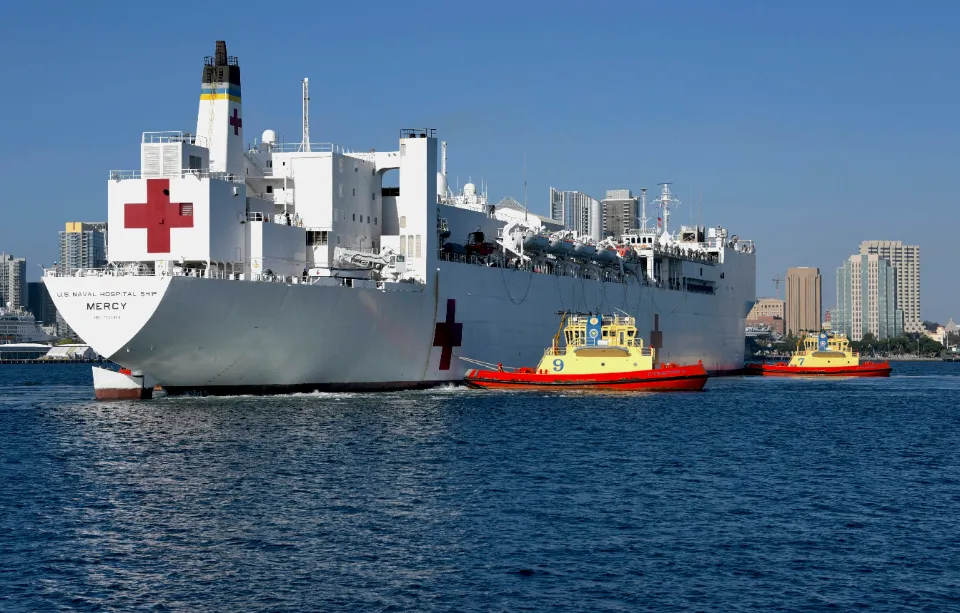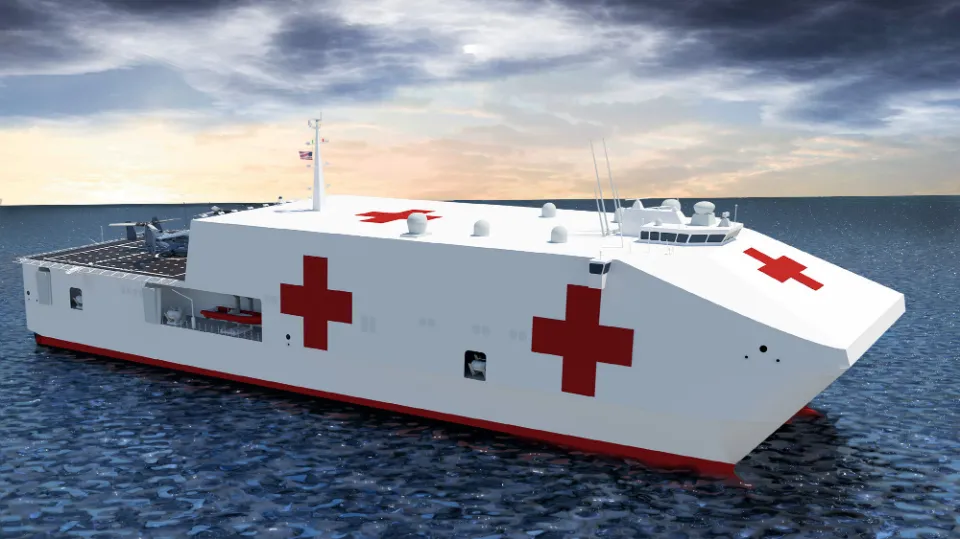U.S. Navy hospital ships provide afloat, mobile, acute surgical medical facilities when called upon by the military. Additional medical ships (ambulance ships, rescue ships, and evacuation ships) have been operating in other capacities.
The ships were both undergoing routine maintenance and repairs when the outbreak started, so even though they were told to get ready, there isn’t a realistic timeline for their departure just yet.
How Many Hospital Ships Does the U.S. Have?
The USNS Mercy (T-AH-19) and USNS Comfort (T-AH-20) are two hospital ships that are part of the U.S. Navy. With their gleaming, bright white hulls and enormous red crosses painted on the sides, these ships are easily identifiable.
Both ships are converted San Clemente-class supertankers that were built in the 1970s by the National Steel and Shipbuilding Company, and then purchased by the Navy and converted to hospital ships in the late 1980s. Operated by Military Sealift Command, both vessels.
Army and Navy Ships
The Navy, however, used the Army Medical Department to staff three hospital ships it operated (AH-6 USS Comfort, AH-7 USS Hope, and AH-8 USS Mercy).
As was previously mentioned, the Navy and Army both operated hospital ships, but for very different reasons. Navy hospital ships were fully equipped hospitals designed to receive casualties directly from the battlefield and also supplied to provide logistical support to front line medical teams ashore, whereas Army hospital ships were essentially hospital transports intended and equipped to evacuate patients from forward area Army hospitals to rear area hospitals (or from those to those to the United
The majority of hospital ships used by the U.S. military were originally designed for a different purpose before being modified. The only ships created for the United States specifically as hospital ships were the three Navy hospital ships. Army fleet—the 24 U.S. Hospital ships operated by the army were repurposed from other ship designs. The Navy had 15 hospital ships in service by the end of World War II.
Some Navy hospital ships were prior Army vessels. As an illustration, the Army bought the passenger ship John Englis in 1896 and renamed it Relief when the Spanish-American War started. In 1902, the Navy acquired the ship and operated it as USS Relief until 1918, when she was renamed to Repose to allow the name of Relief to be assigned to AH-1 USS Relief.
Using the Comfort and Mercy for Coronavirus Response
Only aircraft carriers from the Nimitz-class and Ford-class are larger than the sister ships, which are the third-largest ships in the Navy.
Midway through the 1980s, Mercy—then known as SS Worth—underwent conversion from an oil tanker of the San Clemente class to a hospital ship. A former oil tanker called the SS Rose City, the Comfort is also a converted oil tanker.
Comfort and Mercy are both essentially floating hospitals, each with a 1,000-bed capacity and outfitted with all the amenities you’d find in a standard hospital, including blood banks, morgues, and oxygen-production plants.
Given that their purpose is to treat injured soldiers, the ships are built with trauma cases in mind. They are not intended to control an outbreak of an infectious disease for a variety of reasons. Only non-COVID-19 cases will be supported by the ships because they are unable to isolate infectious patients.
The fact that some of the patient beds on board are actually stacked on top of one another and that the ship uses metal handrails, where coronavirus can survive for hours, complicates their support of the outbreak even more. Some people question whether using the ships is even necessary.
Not for the first time, a hospital ship turned out to be less than helpful. Witnesses say the Mercy actually hit the USS Arizona Memorial in Pearl Harbor while sailing “dangerously close” to it.
Deploying the Comfort and Mercy

The laws governing the two ships’ non-combatant status are distinctive to them. They do carry weapons, but only defensive armaments, and they can’t transport members of the Navy who hold combat specialties, such as naval aviators, special operations troops or submarine or surface warfare officers.
Also absent from the ships are Marine Corps personnel. As a result, the Military Sealift Command’s civilian employees are typically the ones operating them. Firing on the Comfort or the Mercy would be a war crime under the Geneva Conventions.
In their home ports, the ships are operating on a limited basis. While the Mercy is at home in San Diego and the Comfort is berthed at Naval Station Norfolk, Virginia, there are fewer than 75 crew members on board.
Once activated, the ships are typically ready to set sail in five days with a crew that includes more than 1,200 military medical personnel and about 60 civilian mariners.
The biggest problem with staffing the hospital crews during the coronavirus response is that many of them are civilian reservists, and activating those specialties would remove them from the civilian population.
Past Uses of the Comfort and Mercy
Both Comfort and Mercy have experienced some conflict. Both of them were sent out to aid in Desert Shield and Desert Storm operations.
Mercy, which primarily serves the Pacific, frequently deploys for training exercises and in response to natural disasters. Comfort has historically seen a lot more action. Operation Uphold Democracy, a U.S. initiative, was supported by its deployment. military intervention in 1992 saw Haiti and later helped the United States.-led invasion of Comfort also supports humanitarian operations and training. Iraq in 2003.
The ships have already deployed within American waters before. Comfort deployed to New York City in response to the 9/11 attacks to help the local hospitals. It also sailed for New Orleans in the aftermath of Hurricane Katrina and to Puerto Rico following Hurricane Maria.

